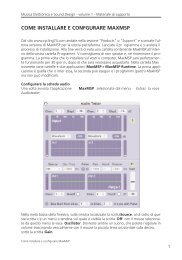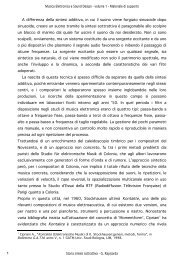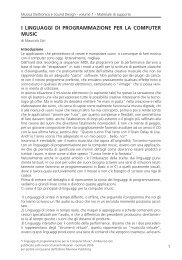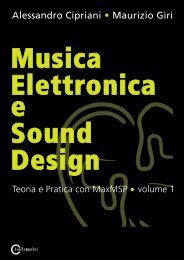programming with max/msp - Virtual Sound
programming with max/msp - Virtual Sound
programming with max/msp - Virtual Sound
You also want an ePaper? Increase the reach of your titles
YUMPU automatically turns print PDFs into web optimized ePapers that Google loves.
Electronic Music and <strong>Sound</strong> Design - Introduction<br />
algorithms from scratch, the replacement of parts of pre-built algorithms, and<br />
reverse engineering (in which the reader listens to a sound and then tries to<br />
invent an algorithm to create a similar sound).<br />
These activities and tasks are intended to activate the knowledge and practical<br />
skills of the reader. When learning a foreign language, there is a gap between<br />
what one knows and what one is able to use in practice. It is common for a<br />
student’s passive vocabulary (the total number of terms that the student can<br />
recognize) to be much larger than the active vocabulary that he or she can actually<br />
use while speaking or writing. The same is true of a <strong>programming</strong> language:<br />
a student can understand how algorithms work <strong>with</strong>out being able to build<br />
them from scratch. The activities in this book that concentrate on replacing<br />
parts of algorithms, completing unfinished algorithms, correcting algorithms<br />
<strong>with</strong> bugs, and reverse engineering, have been included in order to pose problems<br />
to which the reader is encouraged to find his or her own solutions, causing<br />
the learning process to become more active and creative.<br />
When learning a foreign language, students are given replacement exercises<br />
(e.g. “replace the underlined verb in the following phrase: I wish I could go<br />
out”), correction exercises (e.g. “correct the following phrase: I want to went<br />
home”), and sentences to be completed (e.g. “I’d like to ... home”). In this<br />
context, it is vitally important for the student to work at these activities in order<br />
to avoid an excessively passive approach to learning. Our approach, likewise,<br />
not only involves interactions between the perception of sounds and the knowledge<br />
deriving from reading the book and doing the practical activities, but also<br />
interactions between these two factors and the user’s own skills and creativity.<br />
This method is not based on a rigidly linear progression, but is rather a<br />
network that enables the reader to acquire knowledge and practical skills<br />
through an interaction of four separate dimensions: learning of the theoretical<br />
concepts, learning to use the Max/MSP program, interacting <strong>with</strong> example<br />
material, and constructing algorithms.<br />
MAX/MSP<br />
The practical parts of this book are based on the software Max/MSP. This<br />
program, written originally by Miller Puckette, was extensively revised and<br />
expanded by David Zicarelli, and is published as a supported product by Cycling<br />
’74 (www.cycling74.com). Max/MSP is an interactive graphic environment for<br />
music, audio processing, and multimedia. It is used throughout the world by<br />
musicians, composers, sound designers, visual artists, and multimedia artists,<br />
and it has become a de facto standard for modern technologically-enabled<br />
creative projects in both the musical and in the visual spheres.<br />
It is a graphic <strong>programming</strong> language, and is therefore relatively easy to learn,<br />
especially given its great power and expressivity. In Max/MSP one creates programs<br />
by connecting onscreen graphic objects <strong>with</strong> virtual cables. These objects<br />
can perform calculations, produce or process sounds, render visuals, or be<br />
configured as a graphical user interface. Using its sound synthesis and signal<br />
processing capabilities, one can fashion soft-synths, samplers, reverbs, signalprocessing<br />
effects, and many other things.<br />
from “Electronic Music and <strong>Sound</strong> Design” Vol. 1 by Alessandro Cipriani and Maurizio Giri<br />
© ConTempoNet 2010 - All rights reserved<br />
XI







